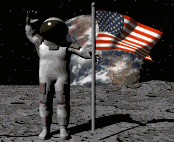|
|
|

|
GALACTIC FACTS
|
|
Here are some fascinating facts about the final frontier,
our universe!
|
|
|
The average life span of a yellow star, like our Sun, is about 10 billion years. The Sun will eventually burn out in about 5 to 6 billion years.
|
|
The Andromeda Galaxy is our closest neighboring galaxy at 2.2 million light years away. It is so bright you can see it with your own eyes on a clear evening sky, away from city lights.
|
|
|
The average temperature on Pluto is -390 degrees Fahrenheit.
|
|
|
The planets Mercury and Venus are the only planets in our solar system that don't have moons.
|
|
|
If the planet Jupiter was hollow, you could fit about 1,400 Earth sized planets inside of it with a little room to spare.
|
|
|
|
The planet Venus spins the opposite way than the other planets.
|
|
|
The brightest star in the sky is Sirius. Also known as the dog star, it is 51 trillion miles from Earth or about 8.7 light years.
|
|
|
To reach outer space, you need to travel at least 50 miles from the Earth's surface.
|
|
|
The planet Mars was named after the Roman god of war. The month of March is also named for him.
|
|
|
For centuries people thought the appearance of a comet was a evil sign that could fortell the coming of plagues, wars and death.
|
|
|
|
The largest asteroid on record is Ceres. It is so big it would stretch from Washington D.C. to Louisville, Kentucky. A distance of over 600 miles!
|
|
|
The planet Jupiter has no solid surface, only layers of gaseoes clouds. It is composed mainly of hydrogen and helium.
|
|
|
The average size of a meteor is no bigger than a grain of sand!
|
|
|
The Earth spins faster on its axis in September than it does in March!
|
|
|
On March 29,1974 Mariner 10 was the first spacecraft to fly by the planet Mercury. It sent back close-up pictures of a world that resembles our Moon.
|
|
|
|
Click on a topic below for more FUN FACTS.
|
|
|
|
|
|
|


 AMAZING ANIMALS
AMAZING ANIMALS
